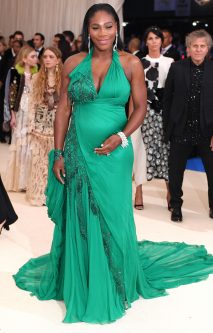Earlier this week, I woke up to images of a glowing pregnant barely covered Serena Williams gracing the cover of Vanity Fair on my Instagram feed. There is no specific word or words I could muster up, to adequately express about how I felt about the images as I sped read the cover story while enjoy my morning lazing. My emotional state was a crossover somewhere between feeling proud and satisfied and the urge to be more unapologetic about my raw beauty.
I don’t care for sports, if I were asked about Serena’s accomplishments, I’d have to spend an entire day on Google trying to get my story about her straight and I probably still wouldn’t get it right.
Before I get into why this cover is so significant, let me say that it is important to recognize and appreciate that Serena Williams is one of the most exemplary sportswomen of her 

Serena is a warrior, and even if you don’t appreciate sports, it’s hard not to appreciate someone’s resilience and excellence in a particular craft.
I grew up hearing of the Williams sisters, Serena and Venus, being the unstoppable duo in tennis. They were branded to me as the black success story. More so, their representation was a counter symbolic stance of how black success stereotypes should be perceived. They are important figures for the black community. I, like many others, felt a natural inclination to celebrate them even though I was not well versed on their story and sport.
Apart from Serena’s immense talent and skill, I think what also captivated most people was her ability to claim her body and be proud of it despite years of sexist and racist remarks being thrown at her, even by her peers. It was through that, that we learned to appreciate her individual, graceful beauty and discover why it is that society doesn’t permit such beauty.
After Serena’s win at the French Open in June 2015, she was equated to an animal, a gorilla to be exact. Her anatomy was compared to a man and many found her image unattractive.
Serena’s built is powerful, a common structure amongst women in the black community. Serena and many other black women out there, don’t resemble the usual cover girls and for years the image of the black woman has been opposed and made fun of. One might go as far back as 19th century Europe and Sarah Baartman who was trafficked from Africa and put on display as the ‘Hottentot Venus’ because of her buttocks.
The long-term sexualisation of black women’s bodies has evolved into today’s generational norm that sees particularly African American sportswomen as “pornographic eroticism and sexual grotesquerie” individuals, according to James Mc Kay in the published article ‘Social Identities’.
We have socially schooled to think that women with features like Serena aren’t beautiful and though exhibitions like the one Sarah was subjected to are not in existence today, the words and actions of some give a hint of the derogatory thoughts that persist.
Serena, especially, has faced abuse that would make a lesser woman crumple. I find her bravery and resilience to defy odds remarkable.
This cover is important as it flips the switch on what was once reviled, even by magazines similar to Vanity Fair. It is a symbol of courage for women who are taught to scorn themselves. There simply aren’t words to fully express the depth of this cover for Serena and for women who look like Serena. I suppose it is meant to evoke certain feelings. It has certainly done so.





